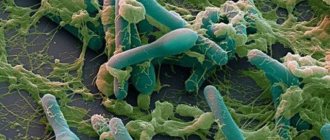general description
Gastroptosis is the prolapse of the stomach, which is accompanied by hypotension and elongation.
Most often, the disease is registered in women 16-50 years old. In the early stages it is asymptomatic. Then, as gastroptosis progresses, the patient begins to experience abdominal pain after eating or exercising.
In addition, advanced forms of the disease lead to prolapse of other internal organs with the appearance of corresponding symptoms. The main methods of treating gastroptosis are physiotherapy and exercise therapy.
Causes of gastroptosis
The reasons for the development of primary gastroptosis are:
- bend of the upper part of the duodenum;
- body features (tall, elongated limbs and fingers on them, thinness, long neck, narrow sternum, weak muscles);
- bowel prolapse.
The secondary form of the disease occurs against the background of the following conditions of the body:
- sudden weight loss;
- surgical intervention for the treatment of ascites;
- hypovitaminosis;
- undergone surgery to remove stomach tumors;
- poor nutrition, lack of protein in the diet;
- frequent childbirth;
- lung diseases that lead to prolapse of the diaphragm;
- Regular weight lifting, weightlifting and other strength sports.
Kinds
There are two types of illness:
- Congenital, also called constitutional. This congenital pathology is due to the peculiarities of the morphological structure of the human body. An asthenic physique is characterized by a disproportionate structure: the chest and shoulders are narrowed, and the body itself is elongated.
- Acquired – caused by weakening and stretching of the gastric ligaments. It can occur after childbirth, surgery, or after sudden weight loss.
Regarding the distribution in the intestine, it happens:
- partial – accompanied by muscle lengthening and low peristalsis;
- total – accompanied by numerous pathological changes in other internal organs.
There are 3 stages of prolapse, each of which is determined by the distance between the lower border of the stomach and the pectineal line:
- first - the intestine is 2 or more centimeters above the pectineal line;
- second - they are on the same level;
- the third is visible omission.
Symptoms of prolapsed stomach
The clinical picture largely depends on the severity of the disease. There are 3 degrees of gastroptosis, depending on the position of the upper concave edge of the stomach (above, at the level or below the line of the gallbladder).
| Stages of gastroptosis |
At the first and second stages, signs of gastroptosis are not expressed. The patient may complain of the periodic occurrence of the following symptoms:
- a feeling of heaviness in the upper abdomen, which intensifies after eating;
- frequent constipation, flatulence;
- heartburn;
- aversion to dairy products;
- nausea;
- change in gastronomic preferences.
At the third stage of the disease, pronounced symptoms appear:
- acute pain in the epigastric region, which intensifies with movement and decreases at rest;
- burping “rotten”;
- autonomic disorders: dizziness, tachycardia, increased irritability, hyperhidrosis;
- constipation, which is replaced by diarrhea;
- hypovitaminosis.
2. Symptoms of the disease
The most common symptoms of gastroparesis are:
- Feeling of fullness in the stomach after eating a small amount of food;
- Nausea;
- Vomit;
- Food goes back into the throat without nausea or vomiting.
A person with gastroparesis may experience occasional high or low blood sugar levels. Conversely, gastroparesis may be suspected in people with diabetes who suffer from upper gastrointestinal problems. Controlling your blood sugar levels may reduce the symptoms of gastroparesis.
Visit our Gastroenterology page
Diagnosis of gastroptosis
The main methods for diagnosing the disease are:
- collecting anamnesis, interviewing the patient;
- external examination - the doctor notices a slightly saggy lower abdomen;
- Ultrasound;
- esophagogastroduodenoscopy;
- electrogastrography;
- radiography using a contrast agent.
| Gastroptosis: X-ray |
General information
Gastroptosis is a prolapse of the pyloric part of the stomach or its lesser curvature.
Less common is prolapse of the entire organ. The pathology can be congenital or acquired. The disease mainly affects young women. Most often, gastroptosis occurs in patients aged 15 to 45 years, however, the pathology can also be diagnosed in older age groups. The predisposition to the disease in the fairer sex is associated with excessive thinness, frequent diets, childbirth with subsequent sprain of the ligaments and muscles of the abdominal wall. In males, gastroptosis develops when lifting heavy objects with improper load distribution and poor physical activity. Prolapse of the stomach can be easily corrected with massage sessions, therapeutic exercises and other conservative methods.
Treatment of gastroptosis
Therapy for the disease is complex and includes several stages.
Diet
The diet for gastroptosis includes easily digestible foods. You need to eat at the same time, in small portions (5-6 times a day, in small portions). After eating, you need to take a horizontal position for at least half an hour.
If the patient has a decreased appetite, then taking foods with a choleretic effect is indicated. If you have constipation, you need to eat more foods rich in plant fiber.
| List of foods allowed for gastroptosis | List of foods prohibited for gastroptosis | ||
| oatmeal/buckwheat porridge with water | semolina porridge, rice | ||
| vegetables and fruits | fatty, spicy, salty | ||
| dairy products | marinades, smoked meats, pickles | ||
| boiled dietary meat and fish | fresh bread, sweet products | ||
| low-fat broth | coffee, cocoa | ||
| compote, weak tea, juice | carbonated, alcoholic drinks | ||
Exercises for prolapsed stomach
All patients diagnosed with gastroptosis are prescribed courses of physical therapy. The attending physician selects exercises based on the severity of the disease, age and individual characteristics of the patient’s body.
Perform the exercises in a lying position, legs should be slightly elevated. The main load should fall on the abdominal cavity and legs. The patient needs to lift and bend his legs at different angles while lying down.
The training is completed with an abdominal massage, after which the patient should spend some time at rest.
| Exercises for prolapsed stomach |
Drug therapy
Treatment of gastric prolapse with drugs is prescribed at the third stage of the disease. Therapy is symptomatic and includes taking the following groups of medications:
- antispasmodics - to relieve cramps and abdominal pain;
- sedatives - to relieve or reduce autonomic disorders;
- enzyme preparations - indicated for disturbances in the production of gastric juice.
Surgery
It is rarely used for prolapsed stomach; surgery is usually performed if frequent relapses of gastroptosis occur. In addition, surgical intervention may be prescribed if massages, exercise therapy, diet and medications do not produce results, and the patient’s condition continues to deteriorate.
Complications
The consequence of gastroptosis is often gastric atony; the presence of splashing noise and mainly movement disorders confirms the diagnosis.
Prolapse of the stomach is causally related to chlorosis, which so often develops in females during puberty.
Also important complications of gastroptosis include inflammation of the gastric mucosa (due to irritation from stagnant food), gastric ulcers and actual dilatation of the stomach.
Gastroptosis prognosis
With timely treatment, the prognosis is favorable. If therapy for gastroptosis is not carried out, the disease continues to progress, the stomach begins to put pressure on the intestines, which also shifts and begins to put pressure on the prostate in men, the uterus in women, which leads to the appearance of new unpleasant symptoms and a further deterioration in the patient’s quality of life.
In addition, the consequences of gastroptosis can be:
- weakening of the motor and secretory functions of the stomach;
- slowing down the movement of the food coma through the gastrointestinal tract;
- development of stomach and intestinal cancer.
Pathological anatomy
Regarding the pathological anatomy of gastroptosis, it is important to point out some points of great importance. Firstly, the data from an intravital study can diverge quite significantly from what is found on the corpse. Regarding the position of individual parts of the stomach, it should be noted that the cardia represents the most fixed part of the stomach, while the pylorus is the most mobile part, shifting even under normal conditions when the stomach is filled and during breathing. Therefore, the pyloric part of the stomach is most often and most strongly subject to displacement, in which the movable upper and middle knees of the duodenum can also take part.
Due to prolapse of the stomach, small intestines are often introduced between the cardia and the pylorus, and the pancreas is often exposed along the lesser curvature.
As for the walls of the stomach, they have different properties, often depending on the concomitant disease of the stomach (dilatation of the stomach, etc.). They are either thickened in all or several layers, or, on the contrary, thinned. These anatomical changes, which must be placed in direct connection with the abnormal position of the stomach, are often accompanied by others, depending on complications.
Prevention of gastroptosis
The main measures to prevent the disease are:
- if you have low body weight, visit a nutritionist and develop a diet that will help you gain the required weight;
- giving up a sedentary lifestyle - regular walks in the fresh air, physical exercise;
- normalization of diet;
- refusal of heavy physical labor;
- Women's use of contraceptives - too frequent childbirth can lead to the development of gastroptosis.
Good health to you!
PATHOGENESIS
Gastroptosis occurs due to various disorders in the patient’s body, which determine the type of disease - congenital or acquired gastroptosis. Congenital gastroptosis is very often observed in patients with asthenic syndrome. Acquired gastroptosis can appear most often as a result of sudden weight loss, in the postpartum period, after abdominal surgery.
With this disease, the ligamentous apparatus responsible for fixing the position of the stomach is stretched inside the abdominal cavity. Most often you can find anthropopyroptosis in combination with elongation and hypotension of the stomach. Total gastroptosis is observed only with simultaneous prolapse of both the diaphragm and the stomach.
List of sources
- Stepanov N.P., Ivanov A.I., Tobokhov A.V., Nikolaev V.N., Sleptsov V.D. “Diagnostics and surgical correction of gastroptosis”, article in the journal “Clinical Medicine”
- Shulgai A.M., Kabakova A.B., Klim L.A., Glushko K.T. “The problem of gastroptosis as a manifestation of undifferentiated connective tissue dysplasia in the practice of a pediatric gastroenterologist,” article in the journal “Clinical Medicine”
- Plechev V.V., Latypov R.Z. “Pancreatobiliary complications in gastroptosis”, article in the journal “Clinical Medicine”










